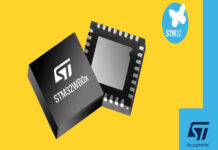The global supply chain has been in continual danger over the last couple of years, affecting everything from toilet paper to autos to popular culinary products. Beyond these present supply chain issues, further investment, particularly in technology, is urgently needed.
5G – The arrival of the fifth generation of mobile networks can alter how we live. Bold technological advancements are already being driven by its power to offer very high data rates, extremely low latency, and enormous network capacity. Most contemporary advances, including autonomous cars, the Internet of Things, AI, and augmented reality, depend on robust, quick, and dependable connections. However, 5G is also improving corporate and personal communications, altering how organizations access, store, share and safeguard data.

The days of shortages may come to an end with the use of next-generation technology, including 5G, in supply chain operations. In the industrial industry, automation and connection will be crucial since they will increase resilience, localization, and global footprint optimization.
The most promising technology for future industrial networks is 5G. Based on the fact that it is a carrier-based cellular technology, fifth-generation networks provide various benefits over 4G technology and fixed and Wi-Fi communication infrastructure.

Many industrial applications use wireless nowadays. Most extensive use cases demand low bandwidths across lengthy communication paths. Applications utilize 900 MHz. 5G increases the frequency.
Higher frequencies equal higher power and data flow. More power and data imply a shorter data transmission distance. Most technological applications need bandwidth for remote access.
Unlike Wi-Fi, it’s licensed and may cover a specific frequency or territory (like a factory). The network may be adjusted to suit coverage, capacity, and commercial needs. Wi-Fi 6 will similarly enhance network capacity but won’t need access authorization. This suggests interference between wireless providers. 5G will provide simpler authentication and cellular connectivity without service selection.

Advantages of 5G in Industrial Automation
- Faster and reliable digital connectivity
- Competitive edge
- Secured, enhanced, and flexible production
- Guaranteed data sovereignty
- Future of 5G in industries
- Enhanced Data Collection
- Increased Automation
- Leverage Augmented Reality For Troubleshooting
- The potential applications for 5G
There are three primary kinds of 5G use cases. There will be applications that cross many categories; ergo, 5G’s broad appeal.
- Extreme mobile broadband (eMMB). Included below are use cases demanding very high bandwidth and data speeds. Applications include streaming high-definition video.
- Massive mobile machine type communications (mMTC). Examples of use cases in this context include those requiring several devices to be placed closely together. Applications include smart cities and timestech (IoT).
- Ultra-reliable low-latency communication (URLLC). Here, use scenarios with high predictability and mission criticality are included. Applications include automated manufacturing and self-driving autos. Here is where Profinet and other industrial networks may use 5G.

The network connection will improve with 5G. This is crucial since the number of IoT devices and the volume of data they produce are growing. One of the most significant sectors in the world, such as, is ready to be disrupted by 5G.-
- Manufacturing
- Energy & Utilities
- Agriculture
- Retail
- Financial Services
- Media & Entertainment
- Healthcare
- Transportation
- AR/VR
- Insurance
- Education
- Cloud Computing
- Gaming
- Real Estate
- Public Safety
- Supply Chain Management
- Restaurants
- Tourism
- Military
- Marketing & Advertising
Due to its strong emphasis on machine-type communications and support for the Industrial Internet of Things, the introduction of 5G wireless technology is anticipated to influence applications for automation and control (IIoT) significantly. Even though the key technological building blocks and implementation issues haven’t been entirely addressed, the potential of Industrial 5G in production is increased by unprecedented dependability and very low latencies.
5G Cases for Manufacturing
Key 5G features – enhanced mobile broadband (eMBB), ultra-reliable low latency communication (uRLLC), and massive machine type communications (mMTC) – support multiple manufacturing use cases across three broad categories:
1. Information Technology
- 5G LAN for offices: Businesses don’t have to create separate, specialized networks, which lowers maintenance and network installation costs.
- Mobile edge computing for IT systems: Instead of transmitting all data to the cloud for processing, the edge network analyzes, processes, and stores data nearer to the client.
2. Operational Technology
- Smart supply chains & warehouses: Facilitating the use of automated picking equipment, automated guided vehicles, warehouse management software, and inventory control platforms.
- Logistics: Tracking the shipment’s whereabouts, planning the most efficient path, using a virtual mechanic, etc.
- Just in time (JIT) manufacturing: Complete elimination of production delays and pauses and accelerating response times with suppliers and consumers.
3. Facilities
- Infrastructure management: Systematic automated tracking and monitoring infrastructure for intelligent manufacturing.
- Video surveillance & security: Response to security issues in real-time, mobile and stationary inspection and monitoring using drones and video analytics.
5G and 4IR in a post-COVID-19 world
5G will play an essential role in increasing the introduction and effect of 4IR technologies in the industrial manufacturing sector, and the COVID-19 pandemic is expected to emphasize the value achieved via higher automation and more innovative, more robust supply chains.
The distinct benefits of 5G-enabled 4IR in further automating the production floor and introducing new services to a wide range of goods will make it a must-have in the post-COVID-19 future.

• Greater automation: With the introduction of 5G, organizations now have many more alternatives for automating processes, increasing efficiency, and increasing agility. Ideally, robots, predictive maintenance, sophisticated analytics, artificial intelligence, and robotic process automation should all be used.
• Increased M&A activity: Businesses seeking strategic acquisitions to strengthen their 4IR capabilities may discover that the impending downturn lowers acquisition target prices.
• Smarter supply chains: US CEOs are adjusting their supply chain and sourcing strategy due to trade tensions. 4IR and 5G technologies will make supply chains more innovative and quicker, not simply shorter. Consider what’s possible with IoT data, real-time blockchain ledger records, and AI-powered analytics: a more agile and transparent global footprint and faster customization, innovation, and reaction times.
• Higher revenues and customer loyalty: Businesses are rapidly using 5G services to establish new income streams by developing 4IR-driven goods and services and embedding 4IR technology into existing analog offerings.
That’s all, Folks!
For manufacturers, 5G communications technology is revolutionary. By 2030, the advantages of 5G to the global industrial sector might reach $740 billion, claims consultancy company STL Partners. 5G connectivity will be crucial in manufacturers’ transformation to “smart manufacturing,” as 5G technology enables them to put IoT data to work. These converged technologies can generate considerable benefits in the long run. Manufacturers will use 5G connectivity to leverage technologies like automation, AI/ML, Internet of Things (IoT), AR/VR, and robotics, enabling them to move toward the “Factory of the Future.” The need for quicker and more secure communication has increased due to Industry 4.0. These devices may be connected to the fifth-generation (5G) cellular network, which can subsequently be used to retrieve and analyze the data.
For instance, employees with AR/VR headsets will be able to wander around the production floor while maintaining connectivity to the private 5G network. Through simulations, users can identify possible problems when dealing with IoT devices. Such corporate use cases will be supported concurrently by 5G’s network slicing functionality. This convergence gives consumers and manufacturers a network platform to securely combine 5G and IoT.
Few firms dispute that 5G networking would significantly improve manufacturing floor operations. However, worries about the price, potential economic benefit, and security of totally wireless systems will likely impede deployment for some years. These reservations should not deter business leaders from generating proofs of concept for 5G’s operational value and launching pilot programs to understand better the technical issues involved. And service providers, such as telecom firms, who want to be a part of the endeavor should invest in creating comprehensive ecosystems of solutions that can assist manufacturers in getting the most out of their 5G installations. This would also enable telecom firms to spread their initial development expenditures among several manufacturing clients in other industries. Finally, firms that want to implement 5G technology sooner rather than later should take a strategic look at the value of 5G, focusing on productivity benefits and increased competitive advantage across the board. Many of the advantages of 5G will be discovered only when organizations acquire experience with it, as with any innovative technology.















